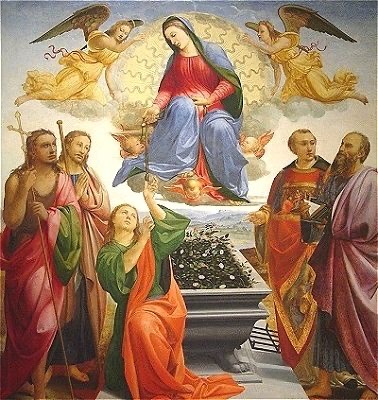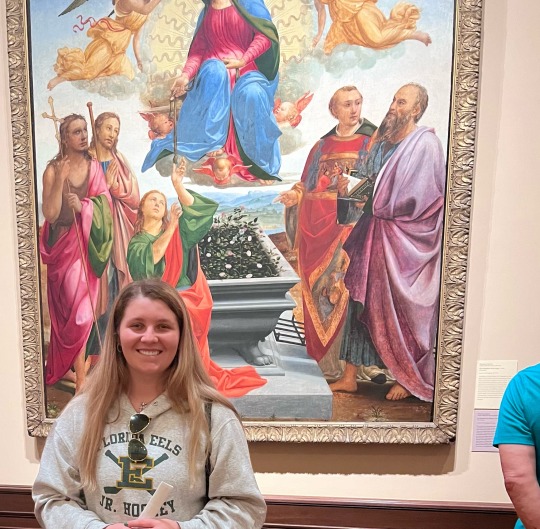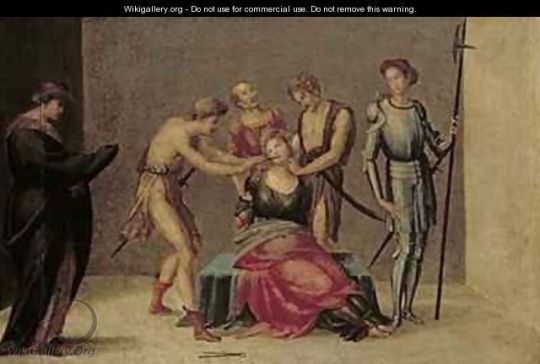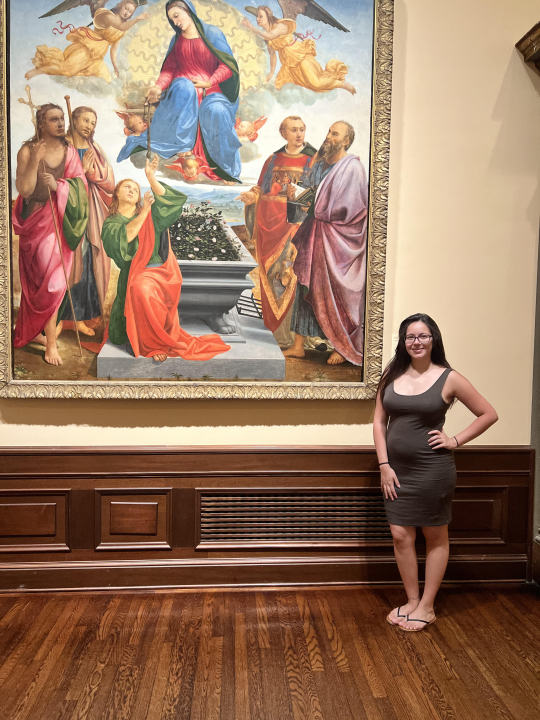#granacci
Text

Francesco Granacci - Madonna of the Girdle. 1515
69 notes
·
View notes
Text

Francesco Granacci, The Crucifixion, 1510 x
1 note
·
View note
Photo

An Angel
Francesco Granacci (1469–1543)
Ashmolean Museum, Oxford
44 notes
·
View notes
Text
Virtual sketchbook #3
For this sketchbook we were asked to see art in the real world at The Ringling Museum of Art. With seeing art in its natural habitat, we were asked to pick one piece of art to observe in detail. With doing a good amount of research on our chosen piece, we also need to include a reproduction of the art piece, specifically a picture, one from the online data base if possible. As well as the title, date, artist, and media. Mondays were free for all students, so that’s when I decided to go to The Ringling Museum of Art, although it was free they didn’t provide wrist bands to prove we went like asked, so instead I took so pictures specifically of the entrance, the map provided, and with my chosen art work I took photos of not only the piece but me with the piece that way it proves I went! I also added some extra pictures of the museum as well at the bottom!
RECREATION: (online database picture)

DESCRIBE PHYSICAL QUALITIES:
My art piece I choose for this project is “The Assumption of The Virgin” by Francesco Granacci, Italian 1469-1543, who was active in Florence. This piece was created in 1515, and was oil on a panel, this panel was 228x205cm. The colors on the actual painting are very vibrant, although on the digital file of the painting they were very dark. The values are very good through out the painting, along with the shading as well with the people, angels, clouds, sky, background, and the whole piece overall. Within every brushstroke there is added detail into the textures of this piece which ads to the overall structure and definition.
The shapes used within this artwork can be broken down into many different parts, you have basic shapes throughout the entire piece. Circles, squares, triangles, many shapes were used throughout to make the people, as well as all of the details. The subject that is represented within this piece is religious, as this piece includes the virgin and the represented saints are Thomas, John the Baptist, James, Lawrence and Bartholomew. “The Assumption of The Virgin” is a balanced piece mostly, the piece as a whole is pretty proportionate, with little differentiation between the saints throughout the painting, with three on the left side and two on the right side. Otherwise the painting is mostly proportionate. There is also some symmetrical aspects as well, with the angels at the top, and also the baby angels along the sides of the virgin.

THIS PART IS ALL ABOUT YOU:
“The Assumption of The Virgin” is a very powerful piece, as it shows the Virgin giving her girdle/belt to one of men. This piece shows a variety of feelings, based on how you may look at it. I personally view this from a religious perspective, which makes it even more powerful to me. I think personally this evokes feelings of wonder for me, as someone who is religious but also doesn’t fully know the entire history behind my religion, this piece allows thoughts of curiosity and interest. I wonder what this piece could mean within other religious viewpoints, and how they make see it versus how I personally see it. Such as does one view it as the Virgin Mary also being lifted up to heaven? Some may also not fully understand it and the meaning behind it. It’s a truly powerful piece for most who view it.

RESEARCH:
The movement within this piece is brought upon Francesco Granacci after he spent a short amount of time in Rome. This is where he assisted Michelangelo in painting the ceiling of the Sistine Chapel in the Vatican. When Granacci returned to Florence he executed this painting for the Medici chapel in San Piero Maggiore. It reflects the contemporary Florentine style. Vasari described it as Granacci’s masterpiece, saying that the figure of St. Thomas could have been painted by Michelangelo himself.
Granacci was telling a story within his piece. This story is about a Christian legend tale that St.Thomas was the apostle who wanted proof of the Virgin’s Assumption. With the term used to denote the taking up to Heaven of Mary’s soul and body three days after her death. The Virgin lowered her belt as proof to Thomas who doubted her. The legend continues as a crusader returned to Prato, which is a town near Florence, from the Holy Land with the belt. Which had been given as dowry to his wife, the daughter of a Greek priest in Jerusalem. The belt was deposited in the Cappella della Sacratissima Cintola in Prato, which accounts for the popularity of this subject in Florentine painting.
Granacci got his message clearly across during the time, as this was one of his most memorable and famous paintings. The praise earned from this painting often came from him being one of Michelangelo’s pupils, leading to his work being compared to Michelangelo himself. With even praise as it was just as good, some even convinced Michelangelo himself painted some portions on this piece. As the work was extravagantly praised by the sixteenth-century critic Giorgio Vasari. He wrote that “the figures of Saint Thomas and the Virgin were so full of grace that they were worthy of Michelangelo”. Indeed, the poses of these figures recall the powerful, three-dimensional forms of Michelangelo's paintings. This shows that Granacci was a detailed and powerful artist, especially with being compared to one the best artists known worldwide.

THE LAST (most important) Part:
In conclusion, “The Assumption of The Virgin” is a historically religious piece, and holds significance in art history and society for several reasons. Firstly, the artwork is a representation of a religious theme, specifically the assumption of the Virgin Mary into heaven. The subject matter was popular during the renaissance period, and reflected the deep religious beliefs of the time. Additionally, the painting has influenced other artist to have created there interpretations of the assumption of the virgin, with each adding their own unique style and perspective. This allowed evolution of this piece of art, and the exploration of different artistic techniques.
Furthermore, the painting hold significance in society as it symbolizes theme, such as religious devotion, the empowerment of women through the portrayal of the Virgin Mary, and the fusion of art with science and theological concepts. This representation of the Virgin Mary ascending into heaven, has served as a source of inspiration and contemplation for viewers throughout history, reflecting cultural norms and beliefs of the time. Overall, “The Assumption of The Virgin” by Francesco Granacci is a notable artwork that has left a lasting impact on art history and society, influencing artist, viewers, and cultural perspective on religion and spirituality, which is exactly why I chose this piece as it stood out to me personally.






1 note
·
View note
Text
Virtual Sketchbook 3
The painting I chose was The Assumption of the Virgin, created by Francesco Granacci in 1515 during the High Italian Renaissance. Granacci created The Assumption of the Virgin for religious purposes and painted it with oil paints on a panel. Granacci’s use of lines in his painting consisted of long curved lines, well-defined lines, and vertical lines. Granacci used an ariel perspective in his painting to show the Virgin Mary being carried by angels in the background and the saints in front on the ground. The painting shows a lot of primary colors throughout the subjects of the paintings, while the background is a monochromatic light blue. There is unity between the angels, the Virgin Mary, and the saints; there is balance with the Virgin Mary in the middle, angels on either side of Mary, and Saints underneath Mary, the side that has more saints they are pointing at Mary to help draw your eyes back up to her. The painting represents the Virgin Mary’s assumption into Heaven; Mary is shown over her empty tomb with angels surrounding her and cherubs underneath her. I feel very drawn visually to this piece of art due to the vibrant colors used. Granacci was a contemporary of Michelangelo, the two of them studied sculpture at the Medici Garden under the supervision of Bertoldo di Giovanni. The Assumption of the Virgin was commissioned by the Medici family. This piece of art shows that Granacci is religious, as well as other pieces of art he created. I believe that The Assumption of the Virgin is a very beautiful piece of art that depicts Mary’s assumption into Heaven. The importance of this piece of art is that it can be used as a holy relic and shows the world now about religion and some of Christianity’s stories. I picked The Assumption of the Virgin because of the vibrant colors as well as how the Virgin Mary is, in the middle of the painting, and looks very loving and welcoming to everyone.



0 notes
Text

Today, Feb 9, our #Catholic & #Christian Friends are celebrating the Feast Day of #StApollonia, patron of #dentists
(and hopefully brushing their teeth afterward)
(www.catholic.org/saints/saint.php?saint_id=104)
Painting details:
https://www.wikigallery.org/wiki/painting_204832/Francesco-Granacci/The-Martyrdom-of-St-Apollonia
The Martyrdom of St Apollonia
by Francesco Granacci
0 notes
Text
Giving clear direction to others
◊ BOHEMIAN SULTAN MEHEMET
◊ BOHEMIAN LEONARDO DA VINCI
◊ BOHEMIAN SIMONE
◊ BOHEMIAN LORENZO NOW
◊ BOHEMIAN MARIA NOVELLA
◊ BOHEMIAN PETER BAPTIZING
◊ BOHEMIAN KING'S SON. THERE
◊ BOHEMIAN FRANCESCO
◊ BOHEMIAN LAURA
◊ BOHEMIAN RAPHAEL
◊ BOHEMIAN MADONNA ENTHRONED
◊ BOHEMIAN IN
◊ BOHEMIAN LEONARDO'S
◊ BOHEMIAN DANTE
◊ BOHEMIAN SAN MICHELE
◊ BOHEMIAN ANGEL
◊ BOHEMIAN FLORENCE
◊ BOHEMIAN KING ROBERT
◊ BOHEMIAN MARIA DEL
◊ BOHEMIAN LEONARDO
◊ BOHEMIAN BERTOLDO
◊ BOHEMIAN SAN MARCO
◊ BOHEMIAN POPE NICHOLAS V
◊ BOHEMIAN FRANCESCO GRANACCI
◊ BOHEMIAN LORENZO DE MEDICI
◊ BOHEMIAN MADONNA
◊ BOHEMIAN GIOVANNI
◊ BOHEMIAN MICHAEL ANGELO
◊ BOHEMIAN RAPHAEL'S
◊ BOHEMIAN PETER. MASACCIO
◊ BOHEMIAN ANGELO
0 notes
Text

Francesco Granacci (Villamagna, Florencia 1469 - Florencia 1543)
Entrada de Carlos VIII en Florencia
hacia 1515-1517
Aceite sobre tabla
Inventario 1890 no. 3908
La pintura representa la llegada de Carlos VIII de Valois, rey de Francia al Palacio Medici, que tuvo lugar el 17 de noviembre de 1494, tras la expulsión de Piero di Lorenzo de'Medici de la ciudad. El palacio muestra el aspecto original de Michelozzi, antes de la ampliación deseada por los Riccardi. Con toda probabilidad, el comisario del cuadro fue el exiliado anti-Medici Francesco Nasi (1498-1571), animado por sentimientos pro-republicanos.
Información de la Gallerie degli Uffizi, fotografía de mi autoría.
0 notes
Text
Holidays 7.23
Holidays
Apolinario Mabini Day (Philippines)
Asian Corpsetwt Day [Every 23rd]
Body Painting Day (New York)
Children’s Day (Indonesia, Vanuatu)
Construction Day (Quebec)
Gorgeous Grandma Day
Guanacaste Day (Costa Rica)
Guayaquil Day (Ecuador)
Historic County Flags Day (UK)
Hot and Bothered Day
Hot Enough For Ya Day
International Hello My Name Is Day
International My Chemical Romance Day
International Yada, Yada, Yada Day
Mayan Sun Festival
Mayhem New Year
Mosquito Day
National Broadcasting Day (India)
National Care for Your Coworker Day
National Dachshund Day
National Russell Day
National Women Touched by Addiction Day
Private Eye Day
Ram Day (French Republic)
Remembrance Day (Papua New Guinea)
Renaissance Day (Oman)
Revolution Day (Egypt)
Simón Bolívar Day (Venezuela)
Soma No Umadi (Wild Horse Chasing; Japan)
Sumarauki (Iceland)
World Castleman Disease Day
World Sjögren's Day
World Whale and Dolphin Day
Yada, Yada, Yada Day
Food & Drink Celebrations
Dessert First Day
National Spongecake Day
National Sprout Day
Peanut Butter and Chocolate Day
Sprinkle Day
Vanilla Ice Cream Day
4th Sunday in July
Auntie's Day [4th Sunday]
International Bog Day [4th Sunday]
National Parents' Day [4th Sunday]
Open Farm Day (Maine) [4th Sunday]
Pisco Day (Peru) [4th Sunday]
Tsushima Tennoo Matsuri (津島天王祭り; Shōjō Festival, Japan) [4th Sunday]
World Day for Grandparents and the Elderly [4th Sunday]
Independence Days
Abkhazia (Declared from USSR, 1992) [partially recognized]
Feast Days
Apollinaris (Christian; Saint)
Beachball (Muppetism)
Bridget of Sweden (Christian; Saint)
Ezekiel (Christian; Prophet)
Feast of Sulis (Goddess of Mineral Springs)
Francesco Granacci (Artology)
Free Hugs Day (Pastafarian)
Groucho Marx Day (Church of the SubGenius; Saint)
Haile Selassie Day (Rastafarian)
Heiromartyr Phocas (Eastern Orthodox)
John Cassian (Western Christianity; Saint)
Leonardo Da Vinci (Positivist; Saint)
Liborius of Le Mans (Christian; Saint)
Margarita María (Christian; Saint)
Mercè Prat i Prat (Christian; Saint)
Neptunalia (Old Roman festival honoring Neptune)
Philipp Otto Runge (Artology)
Phocas the Gardener (Christian; Saint)
Rasyphus and Ravennus (Christian; Saint)
Lucky & Unlucky Days
Taian (大安 Japan) [Lucky all day.]
Premieres
Batman: The Killing Joke (WB Animated Film; 2016)
The Best Little Whorehouse in Texas (Film; 1982)
Bosko at the Beach (WB LT Cartoon; 1932)
The Bourne Supremacy (Film; 2004)
Boneheads (Film; 1993)
Catwoman (Film 2004)
Cinderella Meets Fella (WB LT Cartoon; 1938)
Cold As Ice, by Foreigner (Song; 1977)
Boneheads (Film; 1993)
Double or Mutton (WB LT Cartoon; 1955)
Drop Dead Gorgeous (Film; 1999)
Here Comes Mr. Jordan (Film; 1941)
How Green Was My Valley, by Richard Llewellyn (Novel; 1939)
Inspector Gadget (Film; 1999)
Ramona and Beezus (Film; 2010)
Salt (Film; 2010)
Scooby-Doo! Adventures: The Mystery Map (WB Animated Film; 2013)
Sexus, by Henry Miller (Novel; 1949) [Rosy Crucifixion #1]
Sleigh Bells (Disney Cartoon; 1928)
Springtime for Pluto (Disney Cartoon; 1944)
Tidal, by Fiona Apple (Album; 1996)
The World According to Garp (Film; 1982)
Today’s Name Days
Birgit, Birgitta, Brigita, Liborius (Austria)
Apolinar, Brigita, Ezekijel (Croatia)
Libor (Czech Republic)
Apollinaris (Denmark)
Saida, Seida, Senta, Siina (Estonia)
Oili, Olga (Finland)
Brigitte (France)
Birgitta (Germany)
Lenke (Hungary)
Apollinare, Brigida (Italy)
Ada, Madala, Magda, Magone (Latvia)
Apolinaras, Brigita, Gilmina, Tarvilas (Lithuania)
Brit, Brita, Britt (Norway)
Apolinary, Bogna, Żelisław (Poland)
Oľga (Slovakia)
Brígida (Spain)
Emma (Sweden)
Apollinary (Ukraine)
Bridget, Bridgett, Bridgette, Bridie, Brigette, Brigid, Brigitta, Brigitte, Romeo (Universal)
Roma, Roman, Romaine, Romana, Romelia, Romeo, Romina, Seymour (USA)
Today is Also…
Day of Year: Day 204 of 2024; 161 days remaining in the year
ISO: Day 7 of week 29 of 2023
Celtic Tree Calendar: Tinne (Holly) [Day 14 of 28]
Chinese: Month 6 (Ji-Wei), Day 6 (Ren-Wu)
Chinese Year of the: Rabbit 4721 (until February 10, 2024)
Hebrew: 5 Av 5783
Islamic: 5 Muharram 1445
J Cal: 24 Lux; Threesday [24 of 30]
Julian: 10 July 2023
Moon: 28%: Waxing Crescent
Positivist: 8 Dante (8th Month) [Leonardo Da Vinci]
Runic Half Month: Ur (Primal Strength) [Day 10 of 15]
Season: Summer (Day 33 of 94)
Zodiac: Leo (Day 2 of 31)
0 notes
Text
Holidays 7.23
Holidays
Apolinario Mabini Day (Philippines)
Asian Corpsetwt Day [Every 23rd]
Body Painting Day (New York)
Children’s Day (Indonesia, Vanuatu)
Construction Day (Quebec)
Gorgeous Grandma Day
Guanacaste Day (Costa Rica)
Guayaquil Day (Ecuador)
Historic County Flags Day (UK)
Hot and Bothered Day
Hot Enough For Ya Day
International Hello My Name Is Day
International My Chemical Romance Day
International Yada, Yada, Yada Day
Mayan Sun Festival
Mayhem New Year
Mosquito Day
National Broadcasting Day (India)
National Care for Your Coworker Day
National Dachshund Day
National Russell Day
National Women Touched by Addiction Day
Private Eye Day
Ram Day (French Republic)
Remembrance Day (Papua New Guinea)
Renaissance Day (Oman)
Revolution Day (Egypt)
Simón Bolívar Day (Venezuela)
Soma No Umadi (Wild Horse Chasing; Japan)
Sumarauki (Iceland)
World Castleman Disease Day
World Sjögren's Day
World Whale and Dolphin Day
Yada, Yada, Yada Day
Food & Drink Celebrations
Dessert First Day
National Spongecake Day
National Sprout Day
Peanut Butter and Chocolate Day
Sprinkle Day
Vanilla Ice Cream Day
4th Sunday in July
Auntie's Day [4th Sunday]
International Bog Day [4th Sunday]
National Parents' Day [4th Sunday]
Open Farm Day (Maine) [4th Sunday]
Pisco Day (Peru) [4th Sunday]
Tsushima Tennoo Matsuri (津島天王祭り; Shōjō Festival, Japan) [4th Sunday]
World Day for Grandparents and the Elderly [4th Sunday]
Independence Days
Abkhazia (Declared from USSR, 1992) [partially recognized]
Feast Days
Apollinaris (Christian; Saint)
Beachball (Muppetism)
Bridget of Sweden (Christian; Saint)
Ezekiel (Christian; Prophet)
Feast of Sulis (Goddess of Mineral Springs)
Francesco Granacci (Artology)
Free Hugs Day (Pastafarian)
Groucho Marx Day (Church of the SubGenius; Saint)
Haile Selassie Day (Rastafarian)
Heiromartyr Phocas (Eastern Orthodox)
John Cassian (Western Christianity; Saint)
Leonardo Da Vinci (Positivist; Saint)
Liborius of Le Mans (Christian; Saint)
Margarita María (Christian; Saint)
Mercè Prat i Prat (Christian; Saint)
Neptunalia (Old Roman festival honoring Neptune)
Philipp Otto Runge (Artology)
Phocas the Gardener (Christian; Saint)
Rasyphus and Ravennus (Christian; Saint)
Lucky & Unlucky Days
Taian (大安 Japan) [Lucky all day.]
Premieres
Batman: The Killing Joke (WB Animated Film; 2016)
The Best Little Whorehouse in Texas (Film; 1982)
Bosko at the Beach (WB LT Cartoon; 1932)
The Bourne Supremacy (Film; 2004)
Boneheads (Film; 1993)
Catwoman (Film 2004)
Cinderella Meets Fella (WB LT Cartoon; 1938)
Cold As Ice, by Foreigner (Song; 1977)
Boneheads (Film; 1993)
Double or Mutton (WB LT Cartoon; 1955)
Drop Dead Gorgeous (Film; 1999)
Here Comes Mr. Jordan (Film; 1941)
How Green Was My Valley, by Richard Llewellyn (Novel; 1939)
Inspector Gadget (Film; 1999)
Ramona and Beezus (Film; 2010)
Salt (Film; 2010)
Scooby-Doo! Adventures: The Mystery Map (WB Animated Film; 2013)
Sexus, by Henry Miller (Novel; 1949) [Rosy Crucifixion #1]
Sleigh Bells (Disney Cartoon; 1928)
Springtime for Pluto (Disney Cartoon; 1944)
Tidal, by Fiona Apple (Album; 1996)
The World According to Garp (Film; 1982)
Today’s Name Days
Birgit, Birgitta, Brigita, Liborius (Austria)
Apolinar, Brigita, Ezekijel (Croatia)
Libor (Czech Republic)
Apollinaris (Denmark)
Saida, Seida, Senta, Siina (Estonia)
Oili, Olga (Finland)
Brigitte (France)
Birgitta (Germany)
Lenke (Hungary)
Apollinare, Brigida (Italy)
Ada, Madala, Magda, Magone (Latvia)
Apolinaras, Brigita, Gilmina, Tarvilas (Lithuania)
Brit, Brita, Britt (Norway)
Apolinary, Bogna, Żelisław (Poland)
Oľga (Slovakia)
Brígida (Spain)
Emma (Sweden)
Apollinary (Ukraine)
Bridget, Bridgett, Bridgette, Bridie, Brigette, Brigid, Brigitta, Brigitte, Romeo (Universal)
Roma, Roman, Romaine, Romana, Romelia, Romeo, Romina, Seymour (USA)
Today is Also…
Day of Year: Day 204 of 2024; 161 days remaining in the year
ISO: Day 7 of week 29 of 2023
Celtic Tree Calendar: Tinne (Holly) [Day 14 of 28]
Chinese: Month 6 (Ji-Wei), Day 6 (Ren-Wu)
Chinese Year of the: Rabbit 4721 (until February 10, 2024)
Hebrew: 5 Av 5783
Islamic: 5 Muharram 1445
J Cal: 24 Lux; Threesday [24 of 30]
Julian: 10 July 2023
Moon: 28%: Waxing Crescent
Positivist: 8 Dante (8th Month) [Leonardo Da Vinci]
Runic Half Month: Ur (Primal Strength) [Day 10 of 15]
Season: Summer (Day 33 of 94)
Zodiac: Leo (Day 2 of 31)
0 notes
Text
Quei fichi spiaccicati sulla soglia di casa
Vi ho mai raccontato di quella volta che mi ritrovai i fichi spiaccicati sulla soglia di casa? Una storia curiosa che voglio narrarvi dal principio.
Bisogna tornare indietro nel tempo fino al momento in cui iniziai a metter mano agli affreschi della volta della Cappella Sistina. Avevo bisogno di validi aiuti così chiesi al mio caro amico e collega Granacci di cercarmi nell’ambito della bottega…

View On WordPress
0 notes
Text

Francesco Granacci - Scene of the Life of the Young Tobias. 1535
20 notes
·
View notes
Text

(workshop of) Francesco Granacci, Saint John the Baptist Bearing Witness, 1506-1507 x
0 notes
Text
Benvenuto Cellini: La vita


“Animoso, fiero, vivace, prontissimo e terribilissimo” scrive di lui il Vasari.
Benvenuto Cellini è un precursore del Caravaggio in quanto a temperamento rissoso, collerico, passionale, ma di fondo è un personaggio geniale. Più volte condannato per sodomia, ricercato per risse ed omicidi.
Nacque a Firenze presso il Mercato nuovo il 3 novembre del 1500 da Giovanni di Andrea di Cristofano Cellini ed Elisabetta Granacci.
Il padre, intagliatore d’avorio, è anche un bravissimo musicista, cerca di introdurre il figlio a quest'arte già dalla tenera età mettendolo nelle mani del compositore Fiorentino Francesco dell’Ajolle. Cellini risultò talentuoso nel flauto e nel cornetto, però tollerava poco lo studio della musica, molto più attratto dall’arte dell’oreficeria.
Già all'età di sedici anni a causa di una rissa fu confinato per sei mesi insieme al fratello Cecchino a Siena, dove ne approfittò per frequentare la bottega dell’orafo Francesco Castoro. In seguito il padre lo mandò a Bologna per perfezionarsi nello studio del flauto, ma qui Benvenuto preferì frequentare altre botteghe di oreficeria.
Ritornato nel 1517 a Firenze fuggì dalle pressioni del padre che lo voleva come musicista a Pisa, dove invece continuò a formarsi nella bottega dell’orafo Ulivieri della Chiostra. Tornato a Firenze tra una rissa e l’altra, entrò in contatto con bravi artisti come Pietro Torrigiano e Francesco Salimbene, continuando a lavorare nella bottega di Antonio di Sandro.
Intorno al 1520 prima è a Siena, poi a Roma e nuovamente a Firenze. Nel 1523 è coinvolto in una rissa con i Guasconti, famiglia di orafi fiorentini a lui ostili e ferisce gravemente Gerardo Guasconti, venendo condannato a morte in contumacia. Fugge dunque a Roma dove frequenta altre importanti botteghe fino ad entrare nelle grazie di Clemente VII. Qui lavora nelle bottega di Lucagnolo Da Jesi e Francesco della Tacca.
Nel 1524 aprirà una sua bottega e diverrà primo cornetto di papa Clemente. Questo non gli impedisce di trovarsi ancora nei guai, partecipando ad altri duelli e risse e ammalandosi infine addirittura di peste.

Nel 1527 durante il Sacco di Roma, contribuisce attivamente alla difesa di Castel sant’Angelo contro gli Imperiali. Fu proprio lui che racconta di aver colpito a morte il Borbone mentre questi cercava di scavalcare le mura cittadine. Poi dopo qualche giorno, riesce a ferire anche il Principe d'Orange.
Nel 1529 dopo un breve soggiorno a Firenze torna a Roma presso l'orafo Raffaello Del Moro, Clemente lo promuove Maestro delle stampe della zecca Romana e qui realizza i due celebri carlini d’argento e il doppione d’oro.
Nel suo soggiorno a Roma vendica la morte del fratello Cecchino, morto durante una rissa uccidendo l’assassino, per questo crimine viene solo rimproverato verbalmente dal papa. Benvenuto apre la sua bottega a via dei Banchi nuovi. Sempre iroso ed incline ai litigi, ferisce gravemente un notaio, ser Benedetto, questa aggressione gli procura una condanna che lo costringe a rifugiarsi a Napoli perché ormai Clemente è stanco dei suoi comportamenti e comincia ad ignorarlo.

Alla morte di Clemente VII, è Paolo III Farnese che gli succede. Il papa mal tollera il carattere dell’artista pur apprezzandolo. Benvenuto non si smentisce e assassina un suo rivale, l'orafo Pompeo dei Capitaneis. Il papa però stranamente lo assolve e poi gli commissiona una moneta con la propria effigie. In seguito l’orafo entra in ostilità con Pierluigi Farnese, il figlio del papa, ed è dunque costretto ad andarsene da Roma.
Si reca a Venezia dove però entra subito in conflitto con Ottaviano de' Medici e dunque è costretto di nuovo a cambiare aria e ritornare di nuovo a Roma.
Qui realizza su commissione del papa un uffiziolo di Madonna, che nel 1536 viene addirittura apprezzato dall'imperatore Carlo V.
Nel 1537 lo troviamo a Parigi dove realizza una medaglia per il sovrano Francesco I, poi ritorna nuovamente a Roma dove apre un’altra bottega. Ma Pier Luigi Farnese non si è dimenticato dei suoi crimini e nel 1538 lo fa arrestare ed incarcerare a Castel Sant’Angelo, da dove però il nostro artista riesce a fuggire rompendosi però una gamba durante la fuga. Si rifugia allora presso il cardinal Cornaro, che però lo tradisce consegnando alle guardie svizzere.
Nuovamente incarcerato a Tor di Nona prima e a Castel Sant’ Angelo poi, viene scarcerato nel 1539 per intercessione di Ippolito II d’Este, per il quale eseguirà poi un sigillo e due ritratti.
Siamo ormai intorno al 1540 quando Benvenuto a Parigi riceve da Francesco I un vitalizio annuo di 700 scudi e una residenza presso il castello Petit Nesle. Qui realizza la famosa saliera, il Giove e i modelli per la Porta di Fontainebleau, tra cui la Ninfa e due Vittorie.
Nel 1542 viene naturalizzato come francese. È in questo periodo che produce delle stupende opere d'arte.
Nel 1544 gli nasce una figlia (Costanza), avuta da una sua modella (Caterina). Anche qui il burbero carattere di Benvenuto lo mette di nuovo in difficoltà. Entra dunque in attrito con alcuni cortigiani ed è costretto a ritornare a Firenze, dov’è accolto presso la corte di Cosimo I Medici. Qui diventa scultore di corte ricevendo una paga di 200 scudi all’anno è una dimora in via del Rosario.

Qui realizzerà il famoso Perseo e il famoso busto di Cosimo de’ Medici che però vedrà la luce solo nel 1546. A causa di una condanna per sodomia, sarà di nuovo in fuga e si recherà a Venezia dove conoscerà Tiziano.
In seguito tornato a Firenze cadrà in disgrazia presso i Medici, che gli rifiuteranno ulteriori commissioni stanchi dei suoi comportamenti eccessivi. Nel 1556 viene nuovamente recluso a causa di un'aggressione all'orafo Giovanni Di Lorenzo. Verrà dunque condannato a 4 anni di carcere, commutati in arresti domiciliari.
Tra i 1558 e 1567 Cellini si dedicherà alla scrittura e realizzerà un trattato sull’oreficeria e un trattato sulla scultura, sulla sua vita e altre opere, donandole poi a Francesco I de’ Medici.
Benvenuto morirà il 13 febbraio del 1571 a Firenze e sarà sepolto alla Santissima Annunziata.

Riccardo Massaro
Read the full article
0 notes
Text
3
The Assumption of the Virgin by Francesco Granacci is oil painted on wood. Dimensions include when framed (247.5 x 226.4 x 10 cm), unframed support (227.3 x 205.9 x 7.5 cm). Close to the size of a queen-size bed. The miraculous elevation of Mary, Jesus' mother, into Heaven is shown, painted in vivid and sharply contrasting hues. According to the teaching, the Virgin Mary's body was physically transferred or "assumed" into Heaven after her earthly life. Granacci mostly operated in and around Florence, where the painting was originally designed and held. It is the most well-known Assumption in Renaissance art, if not all Western art. It depicts a significant event in Roman Catholicism – the moment Mary is assumed into Heaven. Dramatic depictions of Jesus Christ's suffering, death, and resurrection clear the religious idea that he was both human and divine. This particular painting provides a similar propaganda technique commonly used in the renaissance period when telling the story of the virgin Mary. This painting impressed me with how well artists could depict their beliefs.
Popularly referred to as the Assunta, the Assumption of the Virgin or Frari Assumption is a sizable altarpiece panel oil painting from the Italian Renaissance master Titian, created between 1515 and 1518. But the image at the Ringling museum made by Francesco Granacci in 1515 is much smaller than its original version. Francesco Granaccis's version includes critical historical figures like st. John the Baptist, St. James, and st. Thomas. According to a Christian narrative, St. Thomas was the apostle who demanded evidence of the Virgin's Assumption, which refers to the bringing of Mary's spirit and body to Heaven three days after her death.
Similarly enough, St Thomas also doubted the resurrection of Jesus. I feel like Granacci thought it was essential to include st. Thomas in this painting because it's like providing evidence to st. Thomas that the virgin mary did indeed ascend to Heaven. This would help persuade those who saw this painting to believe its message. I picked this particular piece because it caught my eye because of its great size and beautiful colors.

1 note
·
View note
Text
Virtual Sketchbook 3
Francesco Granacci painted The Assumption of the Virgin. Granacci created this artwork on an oil-on wood panel. The dimensions are 90 x 81 inches. Granacci used the colors blue, yellow, gold, red, orange, brown, green, purple, silver, white and black in this artwork. This artwork has two angels, five people, and what looks like the Virgin. The five men are surrounding what looks like a grave, and above the grave, the Virgin is located with two angels surrounding the Virgin in the air. There is balance in this artwork, creating a feeling of stability with the help of symmetry and asymmetry. There is symmetry in which both sides have the same elements in the same position in the air. However, the space underneath has asymmetry. Rhythm is created by applying similar colors and arranging shapes and lines together to create a flow. There is also contrast both between the colors and the subjects. It has rhythm, unity, and variety, together making the elements fit comfortably and creating space for the eyes to rest and areas of interest. I believe the essential principle used is the emphasis on creating an area of the composition that is visually dominant and command the viewer's attention. This artwork represents the Virgin (as it says in the title) being praised by people underneath. This artwork makes me feel joy, openness, and calm because of how all the elements are used together. The Assumption of the Virgin is associated with the Renaissance, and the one that commissioned it was the Medici Chapel in Florence, which celebrated the Medici family. This artwork reflects Florentine style, and even though the painting was primarily made for someone else, the way Granacci was able to tell a story so well makes me believe that he may have believed in the story. Additionally, his use of principles of design like asymmetrical balance, emphasis, and directional forces, show us that he is an excellent painter. I believe that Granacci was trying to say through his artwork that The Virgin's death was not like any other death. Instead, angels took the Virgin into heaven, her soul and body. I think Granacci's message comes across very well, and we can clearly understand it with all the elements in his artwork. This painting is important because it represents an important event in Roman Catholicism; The Virgin assumed into heaven. Also, it was a revolutionary composition. Because while earlier religious paintings had been relatively static, this painting has energy and life. I picked this artwork because it stood out to me. Every element focuses on the Virgin being taken up into heaven, and I wanted to know more about its history.

Proof of visit:

0 notes